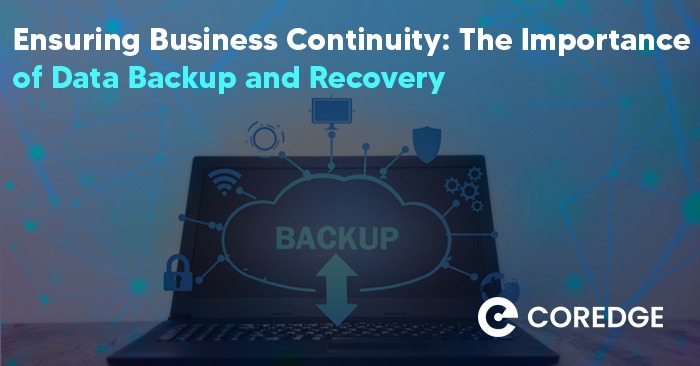Ensuring Business Continuity: The Importance of Data Backup and Recovery
Coredge Marketing
April 21, 2023

As businesses collect larger volumes of data and store them across the organization—from on-premises data centers to hybrid cloud architectures—keeping such data secure and consistently accessible is more important than ever. Such data is becoming more and more dangerous. Ransomware, phishing, and other malicious attacks can seriously reduce your productivity and cause data loss that can be financially disastrous.
Not just attacks pose a threat to data. Little human mistakes can lead to critical data loss. Two additional repercussions of natural catastrophes, such as hurricanes, floods, and fires, are data loss and power outages. Every business needs a dependable data backup and system recovery solution to help it weather unforeseen circumstances and even thrive.
Backup and Recovery
The practice of making and maintaining copies of data that can be used to safeguard enterprises against data loss is referred to as backup and recovery. A phrase that has been used to describe this is operational recovery. The process of recovering data from a backup usually entails restoring the data to its original location or to another site in order to restore lost or damaged data. To lessen the risk of data loss due to primary hardware or software failure, a trustworthy backup copy of the primary data is kept on a different system or medium, like tape.
Challenges faced by organizations
The simplicity of scaling, quick recovery times, system security, dependability of the vendor, and reliability of vendor assistance are a few key factors to take into account when selecting a corporate data backup solution.
Importance of Backup and Recovery
The goal of the backup is to make a copy of the data that can be retrieved in the event that the primary data is lost. Primary data failures can result from hardware or software problems, data corruption, or human error such as a malicious attack (virus or malware), data deletion accident, or other events that were brought on by people. Data can be restored to a previous point in time with the use of backup copies, which can help a business recover from an unanticipated calamity. It is crucial to saving a copy of the data on a secondary medium in order to safeguard against the loss or corruption of original data. An extra storage option could be something as simple as a USB stick or external drive, or it could be something more serious like a disk storage system, cloud storage container, or tape drive. The backup storage media could be farther away or closer to the data source. It may be required to have backup copies of your data at remote locations due to weather-related events.
For optimum results, the quantity of data lost between backups should be maintained to a minimum, hence backup copies should be created often. When recovering from a backup, data loss grows in direct proportion to the time between backup copies. By storing multiple copies of the data, it is possible to go back in time to a time when there was no data corruption or destructive attacks.
The internet banking system for a large bank might be a crucial job; the bank needs to reduce time and data loss. The bank’s application for tracking staff hours is less significant. The bank may, in the event of a catastrophe, permit that application to be unavailable for several hours or perhaps a day without having a significant negative effect on the firm. A structure for your disaster recovery strategy can be created by classifying workloads as Tier 1, Tier 2, or Tier 3. The next stage in creating a disaster recovery strategy is to assess the available deployment choices. The next stage in creating a disaster recovery strategy is to assess the available deployment choices. Do you need to retain backup data or disaster recovery tools on site? Would using a public cloud or hybrid cloud approach be advantageous?
Conclusion
The Coredge platform offers built-in features for backup and recovery. We have incorporated Velero as an add-on with Cloud Orbiter’s backup and recovery capabilities. An open-source tool called Velero conducts backups, restores, and disaster recovery, and migrates persistent volumes and Kubernetes cluster resources. Your application backups can be automated with the aid of Cloud Orbiter.
You may create and manage backups for your apps that are deployed on many clusters across multiple regions using Cloud Orbiter’s simple procedures. You may back up and restore your applications using the simple, user-friendly Cloud Orbiter platform in just a few clicks. You may also download our solution brief of The Kubernetes Clusters Backup & Restore to know more in detail. Connect with us to know more about our product and services.





